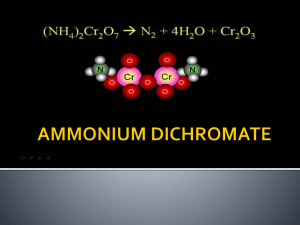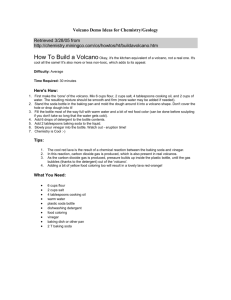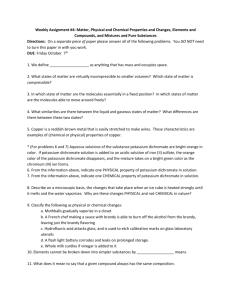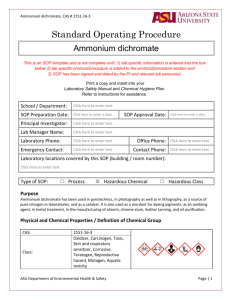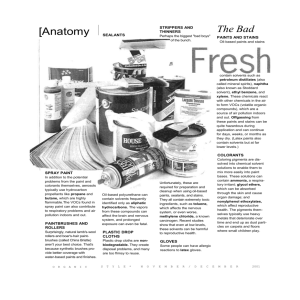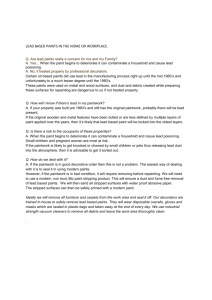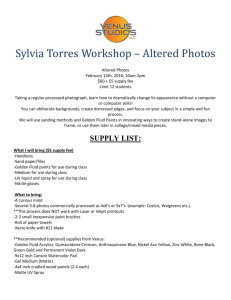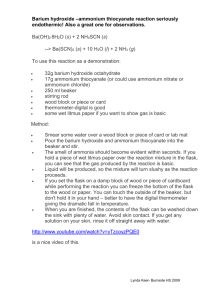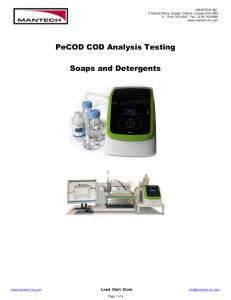COSHH SHEET 50
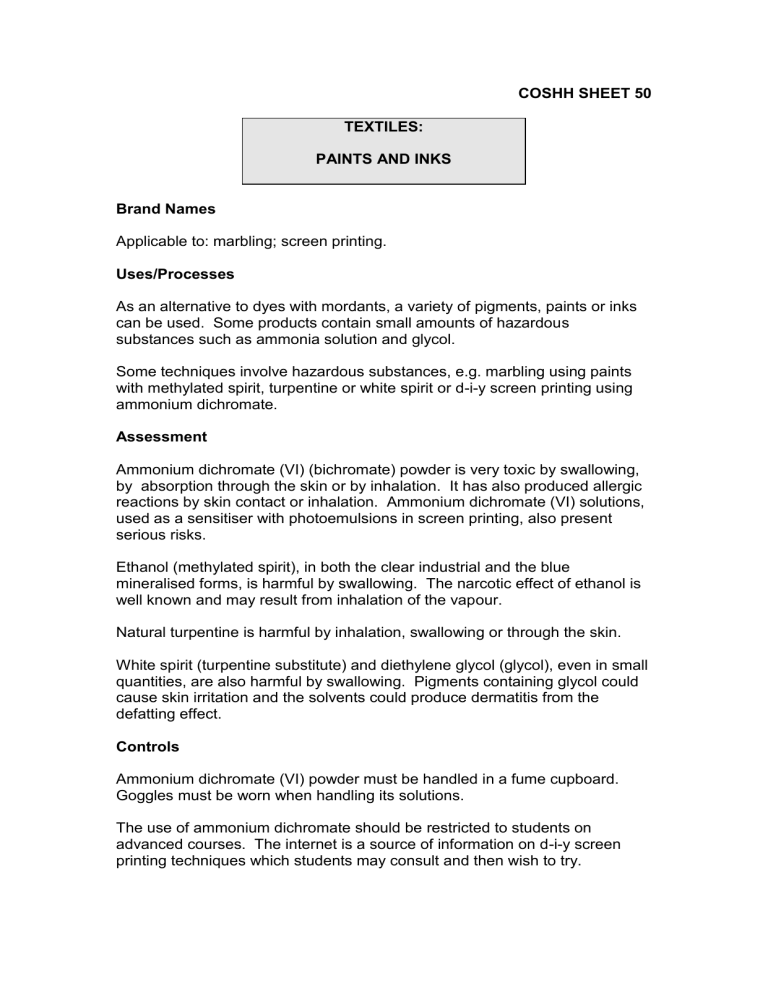
COSHH SHEET 50
TEXTILES:
PAINTS AND INKS
Brand Names
Applicable to: marbling; screen printing.
Uses/Processes
As an alternative to dyes with mordants, a variety of pigments, paints or inks can be used. Some products contain small amounts of hazardous substances such as ammonia solution and glycol.
Some techniques involve hazardous substances, e.g. marbling using paints with methylated spirit, turpentine or white spirit or d-i-y screen printing using ammonium dichromate.
Assessment
Ammonium dichromate (VI) (bichromate) powder is very toxic by swallowing, by absorption through the skin or by inhalation. It has also produced allergic reactions by skin contact or inhalation. Ammonium dichromate (VI) solutions, used as a sensitiser with photoemulsions in screen printing, also present serious risks.
Ethanol (methylated spirit), in both the clear industrial and the blue mineralised forms, is harmful by swallowing. The narcotic effect of ethanol is well known and may result from inhalation of the vapour.
Natural turpentine is harmful by inhalation, swallowing or through the skin.
White spirit (turpentine substitute) and diethylene glycol (glycol), even in small quantities, are also harmful by swallowing. Pigments containing glycol could cause skin irritation and the solvents could produce dermatitis from the defatting effect.
Controls
Ammonium dichromate (VI) powder must be handled in a fume cupboard.
Goggles must be worn when handling its solutions.
The use of ammonium dichromate should be restricted to students on advanced courses. The internet is a source of information on d-i-y screen printing techniques which students may consult and then wish to try.
Work on textiles, using paints and inks and associated techniques such as marbling, must be carried out in a well ventilated area.
Wearing gloves is obviously a sensible precaution to avoid contaminating the skin with paints and inks but such protection is essential with any irritant substances such as photoemulsion sensitiser.
Storage
Solvents and solvent-based paints must be stored in a cool, dry, well ventilated place, away from ignition sources. Up to 50 litres of highly flammable liquid can be held in small containers in a fire-resisting highly flammable liquids cupboard or bin.
Disposal
An authorised waste disposal contractor should be used for solvents or solvent-based paints. Ammonium dichromate solutions are hazardous to the environment and must be treated before disposal via a foul water drain. (See
CLEAPSS Hazcard 7 held in the Science Department).
Immediate Remedial Measures
If paints are swallowed: DO NOT INDUCE VOMITING. Keep the casualty at rest and obtain medical attention.
If ammonium dichromate is swallowed: Vomiting normally ensues. Wash out the mouth; give the casualty a glass or two of water. Obtain medical attention.
If vapour from paints is inhaled: Remove the casualty to fresh air. Keep warm and at rest. If breathing is irregular or has stopped, administer artificial resuscitation. Obtain medical attention.
If paint or ammonium dichromate solution is splashed into the eyes: Irrigate immediately with water for at least ten minutes, holding eyelids apart. If discomfort continues, obtain medical attention.
If paints or solvents are on the skin: Remove contaminated clothing. Wash skin thoroughly with soap and water or use a proprietary skin cleanser. Do not use solvents as greasing agents.
If ammonium dichromate is on the skin: Brush off as much solid as possible, taking care not to inhale the powder. Flood the affected areas with large quantities of water. Remove contaminated clothing and rinse it repeatedly until no yellow colour remains in the water.
If highly-flammable liquids are spilt in the work room: Remove ignition sources. Ventilate area. Contain and collect the spill with non-flammable absorbent material, e.g. sand or mineral cat litter. Store safely pending disposal. Do not allow to enter drains.
